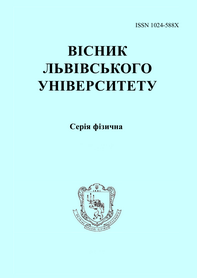DOI: https://doi.org/10.30970/vph.55.2018.78
Luminescence of polymer composites with embedded LaF3:Gd nanoparticles
Ò. Ì. Demkiv, L. I. Bulyk, T. S. Malyi, A. D. Zhyshkovych, M. V. Diachuk, V. V. Vistovsky, A. S. Voloshinovskii

| Visnyk of the Lviv University. Series Physics
55 (2018) ñ. 78-86
DOI: https://doi.org/10.30970/vph.55.2018.78 Luminescence of polymer composites with embedded LaF3:Gd nanoparticlesÒ. Ì. Demkiv, L. I. Bulyk, T. S. Malyi, A. D. Zhyshkovych, M. V. Diachuk, V. V. Vistovsky, A. S. Voloshinovskii |  |
The luminescence properties of polymeric films based on polystyrene matrix with embedded LaF3:Gd nanoparticles were studied. In the luminescence spectra of LaF3:Gd nanoparticles with anaverage size of 30 nm the domination of narrow emission band of gadolinium ions with maximum at 312.2 nm corresponding to 6P7/2 \rightarrow8S7/2 emission transition and half width of \sim1 nm was revealed. The intensity of gadolinium luminescence significantly decreases with decreasing nanoparticle size to 5 nm. This gives the reasons to consider the small size LaF3:Gd nanoparticles as non-radiative particles in the absorption range of the scintillation polystyrene matrix. In the luminescence spectra of polystyrene matrix with organic activators n-terfenyl and POPOP and in polystyrene composites with embedded LaF3:Gd nanoparticles two emission bands with maximums at 350 and 420 nm, that correspond to luminescence of polystyrene activators n-terfenyl and POPOP are observed. The emission intensity on polymeric composite with 40 wt.\% embedded LaF3:Gd nanoparticles increases by approximately an order compared the emission intensity of polystyrene scintillator without any embedded nanoparticles. The luminescence decay time constant of composites is estimated as 3 ns, which is typical for polystyrene scintillator without inorganic nanoparticles. The presence of luminescence response for nanocomposite scintillators with embedded LaF3:Gd nanoparticles confirms that the main mechanism of scintillations in them is the excitation of the luminescent polystyrene matrix by electrons. The electrons are emitted from LaF3:Gd nanoparticles under ionization radiation due to photoelectric effect mechanism and have enough energy to escape the nanoparticle volume with the consequent excitation of luminescence of the polystyrene matrix.